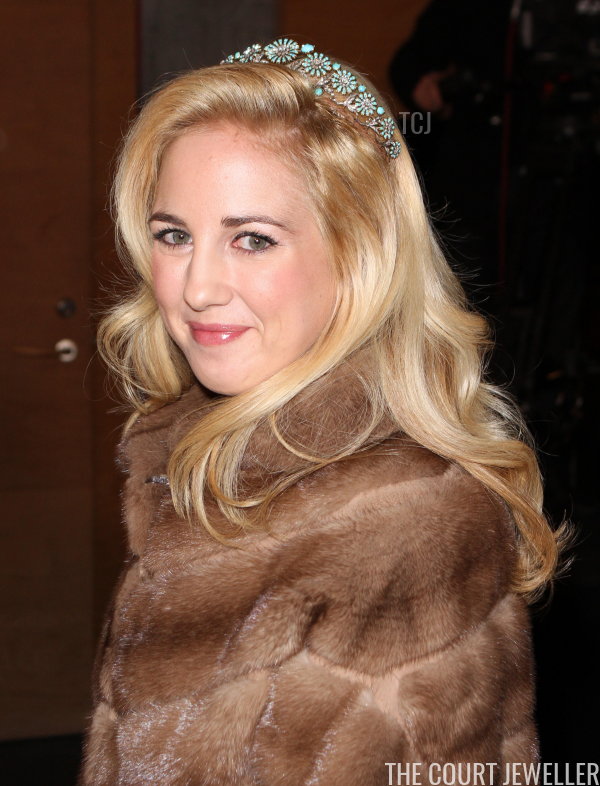 |
| Patrick van Katwijk/DPA Picture Alliance Archive/Alamy |
The Daily Diadem: The Miller Fringe Tiara
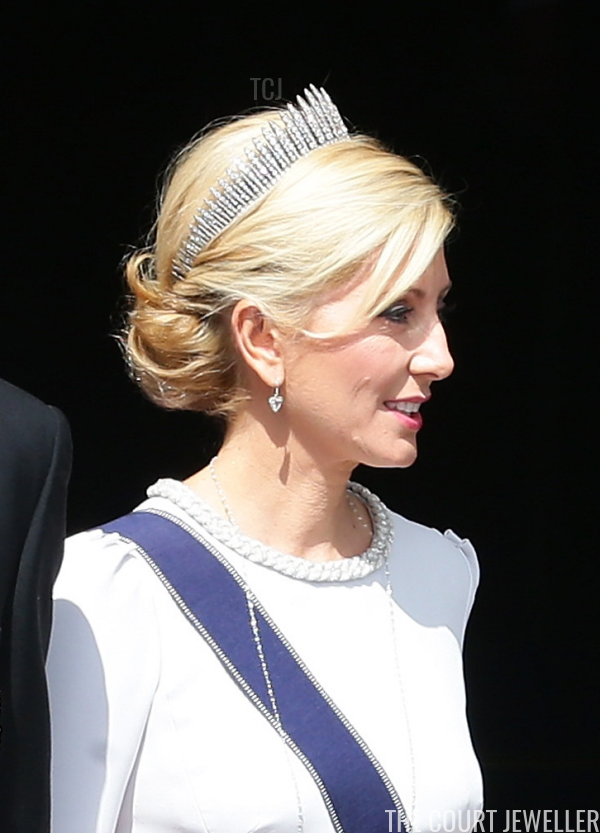 |
| Vittorio Zunino Celotto/Getty Images |
Royal Jewel Rewind: The Greek Royal Wedding of 1964
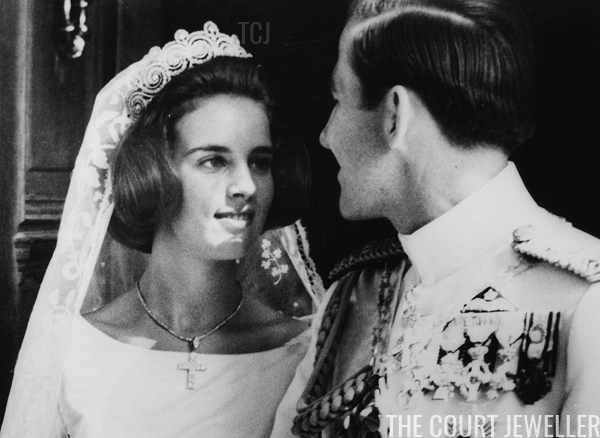 |
| Central Press/Hulton Archive/Getty Images |
Our retrospective of the jewels and history of Greece’s royal weddings continues today with the 1964 nuptials of the country’s last king, Constantine II, and his Danish-born wife, Princess Anne-Marie.
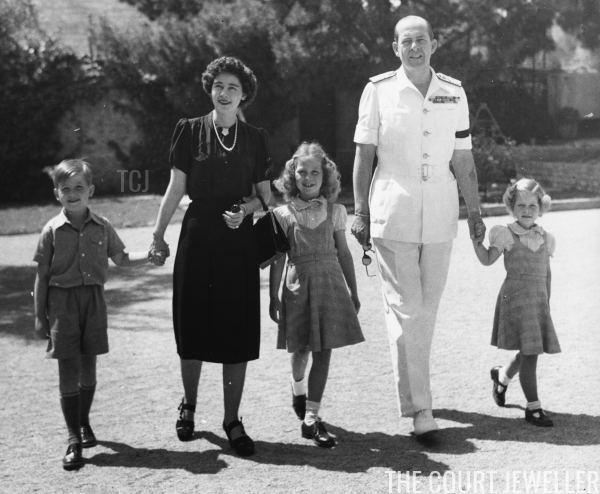 |
| The Greek royal family, ca. 1947: Crown Prince Constantine, Queen Friederike, Princess Sophia, King Paul, and Princess Irene (Chris Ware/Keystone Features/Getty Images) |
When we left the Greek royals yesterday at the end of 1938, Crown Prince Paul and Crown Princess Friederike were happy newlyweds who had just welcomed their first child, Princess Sophia. Less than a year later, Europe was at war. Paul’s brother, King George II, sympathized with the British cause, while Prime Minister Metaxas was pro-German. An attempt was made to remain neutral. In the midst of all of these tensions, Crown Princess Friederike gave birth to her second child. Prince Constantine, named after his Greek royal grandfather, was born at the family’s home in Psychiko in June 1940. Because the Greek royal line practiced male-preference primogeniture, he took precedence over his older sister in the line of succession, becoming Crown Prince Paul’s heir and Greece’s future king.
 |
| King George II, Crown Prince Paul, and Crown Princess Friederike return to Greece, September 1946 |
Baby Constantine was only a few months old when the tensions rumbling in Greece began to break. War was declared between Greece and Italy in October 1940, and in April 1941, after the deaths of Metaxas and his successor, Prime Minister Koryzis, German forces invaded Greece, too. Once again, the Greek royals headed for exile. King George II headed the government in exile in Egypt, South Africa, and Britain throughout the majority of the war, supported by Crown Prince Paul. Friederike and the children stayed with the family as well. In Cape Town, South Africa, she gave birth to the couple’s second daughter, Princess Irene, in 1942. After the end of the war, the royals returned to Greece, arriving triumphantly in Athens in September 1946.
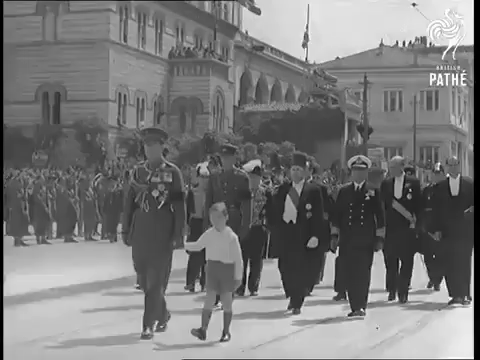 |
| King Paul and Crown Prince Constantine walk in King George II’s funeral procession, April 1947 |
But King George II’s reign only lasted a short while longer. In April 1947, he died suddenly in Athens from a heart condition. Six-year-old Constantine’s father now became King Paul of the Hellenes, and Constantine became Greece’s crown prince. The little prince walked in his uncle’s funeral procession, holding his father’s hand. The Associated Press reported that Constantine, “wearing gray flannel shorts and a white shirt, received an occasional reminder from his father to keep his eyes straight ahead, in keeping with royal demeanor.”
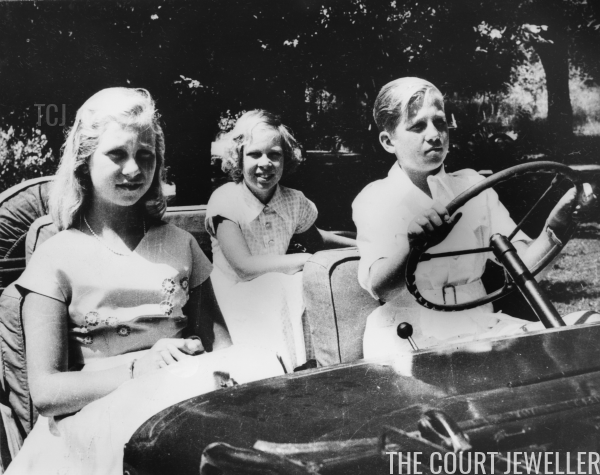 |
| The Greek royal children, ca. 1955 (L-R): Princess Sophia, Princess Irene, and Crown Prince Constantine |
King Paul held on to the throne through Crown Prince Constantine’s childhood, even in the midst of civil war in Greece. Constantine was sent to boarding schools, including Victoria College in Egypt, and received military training. Athletically talented, he earned a black belt in karate and a gold medal in sailing at the 1960 Summer Olympics. He was also a fixture at royal occasions, serving as a train bearer at the wedding of his cousin, King Michael of Romania, in 1948, and accompanying his parents and sisters at events in Greece and abroad.
One of these royal events, a family holiday in Denmark in September 1959, would change the course of Constantine’s life. Crown Princess Margrethe of Denmark threw a ball for young royals at Fredensborg Palace, and Crown Prince Constantine, Princess Sophia, and Princess Irene were all in attendance, along with Crown Prince Harald of Norway and Princess Desiree of Sweden. Rumors in the press at the time linked nineteen-year-old Constantine with Desiree. He did end up meeting his future wife on the trip — but it wasn’t Desiree.
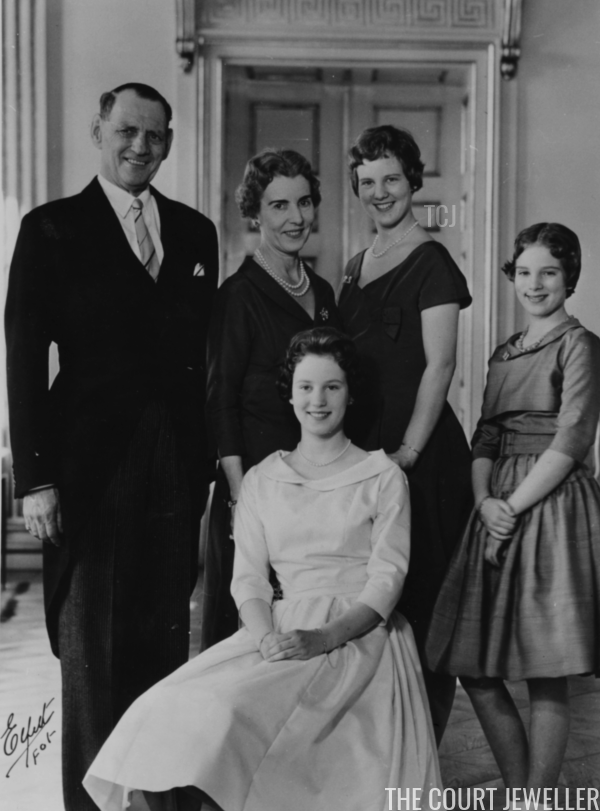 |
| The Danish royal family, ca. 1959 (L-R): King Frederik IX, Queen Ingrid, Princess Benedikte (seated), Crown Princess Margrethe, Princess Anne-Marie |
Like King Paul and Queen Friederike of the Hellenes, King Frederik IX and Queen Ingrid of Denmark were royal cousins who had married in the 1930s and had three children. Crown Princess Margrethe, the country’s future monarch, was born in April 1940, just a few months before Crown Prince Constantine. Two more daughters had followed: Princess Benedikte in April 1944, and Princess Anne-Marie in August 1946. Moreover, Frederik and Paul had acceded to their respective thrones almost simultaneously, both becoming king in April 1947. And, of course, all of them were related in numerous ways. Frederik, Paul, and Friederike were all descendants of King Christian IX of Denmark, while Ingrid, Paul, and Friederike were all descendants of Queen Victoria of the United Kingdom. Paul and Frederik were also both great-great-grandsons of Emperor Nicholas I of Russia.
During the visit of their royal relatives in 1959, King Frederik IX decided to take several of the children and teenagers to see a traveling circus that was open near Grasten Castle. Nineteen-year-old Crown Prince Constantine was one of the attendees; he was seated next to thirteen-year-old Princess Anne-Marie. Though Anne-Marie spoke no Greek, and Constantine little Danish, the two shared English as a common language. The crown prince and princess “hardly were aware of each other’s existence” until that circus visit, according to the press, and Anne-Marie “was a little awed by him.” But a Danish courtier downplayed the idea that any romance was involved in the moment: “Frankly I don’t think it was love at first sight. Anne-Marie probably was much more interested in the animals,” and rightfully so — she was a child, after all. Nevertheless, the circus trip would go down in history as the significant moment when Greece’s future king first met his future wife.
It took years for the youthful friendship to blossom into romance. Constantine and Anne-Marie found themselves in each other’s company multiple times over the next few years, as Constantine was a frequent visitor to Scandinavia. There were plenty of opportunities for Constantine’s eyes to be turned toward other eligible young women. Like his father before him, Constantine’s name was linked in the press with an young Greek woman, the famous blonde actress Aliki Vougiouklaki. Moreover, his parents, King Paul and Queen Friederike, were famous for organizing parties and holidays for all the young royals to attend, both to promote Greek tourism and to give the young royals a chance to meet each other. More than one royal engagement resulted from these parties, including that of Constantine’s sister, Princess Sophia, and Infante Juan Carlos of Spain.
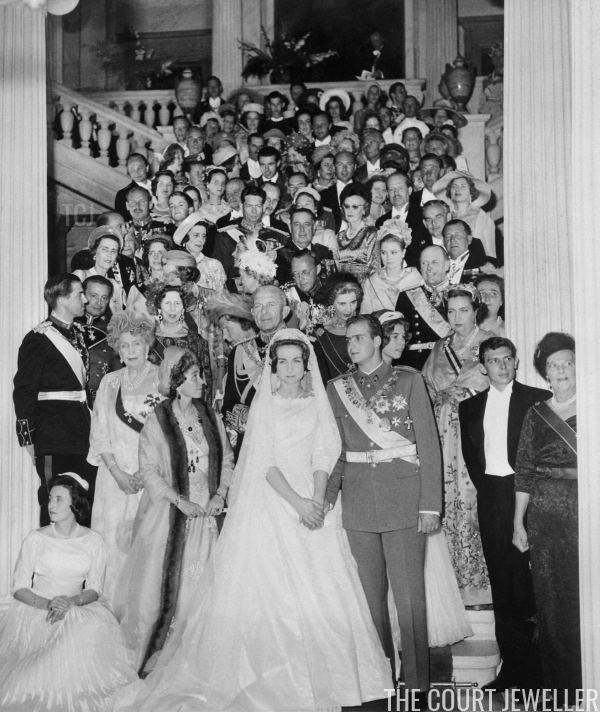 |
| The wedding of Juan Carlos and Sofia in Athens, May 1962 (AFP via Getty Images) |
In May 1962, Princess Anne-Marie arrived in Greece to serve as a bridesmaid at the wedding of Juan Carlos and Sophia. Constantine and Anne-Marie were reportedly inseparable during the wedding festivities. Soon after, one gossip columnist enthused, “The romance between Crown Prince Constantine of Greece and 15-year-old Anna Maria, the youngest daughter of the King of Denmark, is picking up steam. Anna Maria recently left her family to go alone to Norway where Constantine was boat racing. And last week when the Princess returned to Copenhagen, Constantine was right behind her. All this should make Queen Frederika, Constantine’s mother, jump up and down with glee.” On one of Anne-Marie’s birthdays, Constantine surprised her with a visit to her school in Copenhagen. As he sang “Happy Birthday,” she “ran down the stairway, tripped three steps from the bottom and sprawled headlong at his feet in an unladylike heap. She was unhurt, and there was laughter.” In October 1962, Anne-Marie and Constantine were spotted leaving an Athens theater together after a violin concert. Engagement speculation reached an all-time high, even though Anne-Marie was still only sixteen years old.
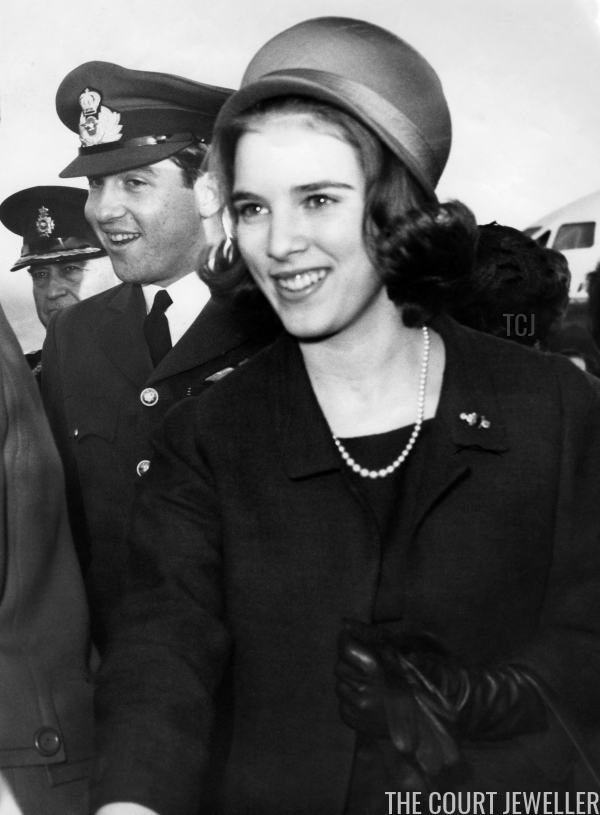 |
| Constantine and Anne-Marie at the airport in Athens (AFP via Getty Images) |
The press didn’t know it at the time, but the couple was already privately engaged, and reportedly had been since that boat racing trip in Norway. King Frederik IX and Queen Ingrid initially balked at the idea of their youngest daughter’s engagement to the future king, largely because she was so young and still attending school. King Frederik was also, quite naturally, very concerned about the political future of the royal family in Greece. One courtier anonymously told a newspaper as early as 1964, “Anne-Marie has been reared to be a princess and a queen, but I’m afraid it might not be long before she is thrown out of Greece, and her father is aware of that.” In the end, Frederik and Ingrid relented only when the couple agreed that they would not marry until Anne-Marie had turned eighteen and finished her education. To help guard against the political dangers, Frederik made the decision to appoint a separate and seasoned Danish ambassador to Athens, a diplomatic role that had previously been handled by their ambassador in Ankara.
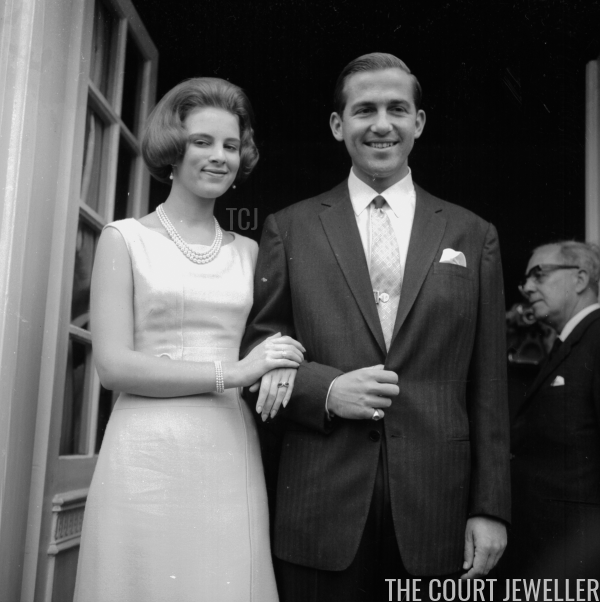 |
| Anne-Marie and Constantine, 1964 (Terry Disney/Express/Getty Images) |
On a frigid, windy day in January 23, 1963, King Paul and Queen Friederike arrived in Copenhagen for the official announcement of Constantine’s engagement to the young Danish princess. The newly-engaged couple appeared in public at the airport holding hands. The Associated Press marveled that the “engagement, long rumored and often denied, was announced almost without warning,” adding that “Amalienborg Palace did not immediately disclose when and where the wedding [would] take place.” Unofficially, plans were made to hold the ceremony two years later, in early 1965, though gossipy press reports claimed that Queen Friederike, worried about the state of the Greek monarchy, had pressed hard to have the wedding held much sooner.
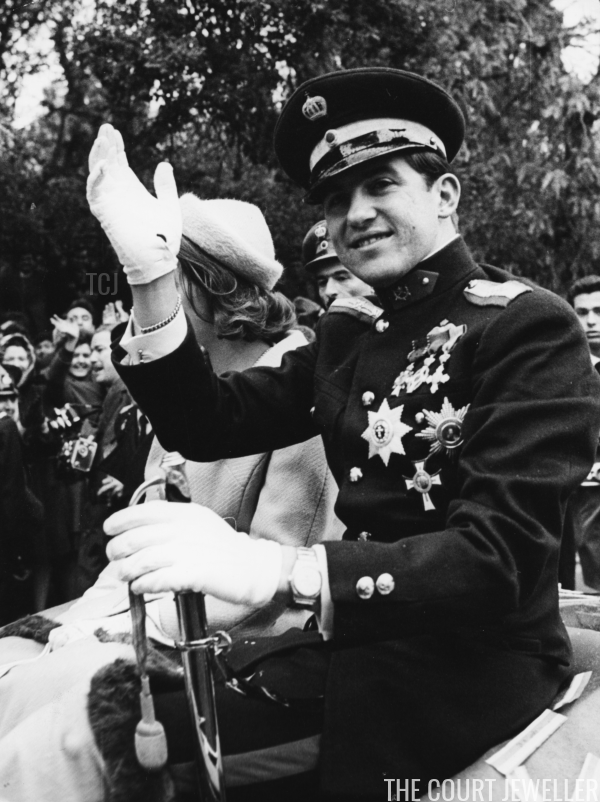 |
| Crown Prince Constantine and Princess Anne-Marie are driven through the streets of Athens, 1963 (Moe/Nordfoto/Keystone/Hulton Archive/Getty Images) |
In the interim, the Danish royals became frequent visitors to Athens, giving the Greeks plenty of opportunities to see their future queen. One of their most prominent appearances there came in March 1963, when the entire Danish royal family traveled to Greece for the celebration of the centenary of the Greek monarchy, as the first modern king of Greece (George I) had been born a Danish prince. In a toast to the Danish royals, King Paul proclaimed, “The welcome of the Greek people has given you a clear picture of what we all feel in Greece for the people of Denmark and your royal family.”
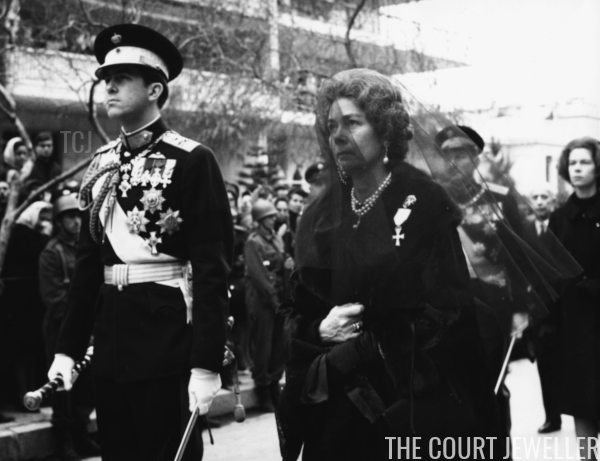 |
| King Constantine II and Queen Friederike walk in King Paul’s funeral procession, March 1964 (Keystone/Hulton Archive/Getty Images) |
But of course — as always seems to be true for the Greek royals — tragedy and disruption was lurking just around the corner. A political crisis was brewing once again in Greece, and demonstrators were vocal about their dislike of the royal family when King Paul and Queen Friederike visited London in July 1963. And then, King Paul’s health began to fail. He’d undergone an operation to remove his appendix in May 1963, and further surgery was done in February 1964. The diagnosis was stomach cancer. Sixty-two-year-old King Paul died in Athens on March 6, 1964, making his son, twenty-three-year-old King Constantine II of the Hellenes, the youngest European head of state. His younger sister, now Crown Princess Irene, temporarily became the heir to the Greek throne. Princess Anne-Marie attended the late king’s state funeral with the rest of the Greek royals and her parents. (Another Greek family member, the Duke of Edinburgh, had to rush to Athens for the funeral, which was held less than 48 hours after the birth of his youngest child, the Earl of Wessex.)
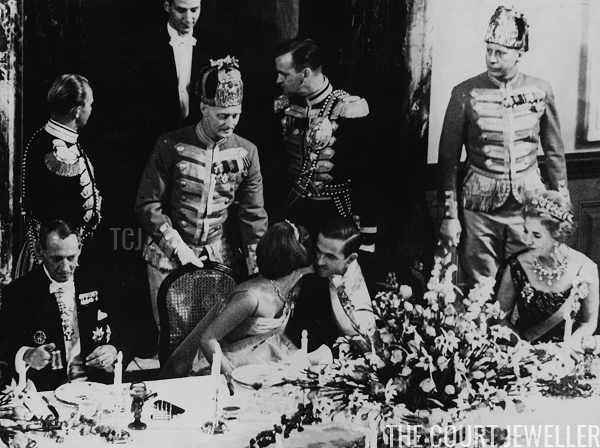 |
| Anne-Marie’s farewell banquet at Christiansborg Palace, September 1964 (Keystone/Hulton Archive/Getty Images) |
After King Paul’s sudden death, a plan to push the wedding forward was put in motion. The official period of mourning for the late king would end in September. Anne-Marie’s eighteenth birthday was on August 30, 1964, and the wedding was scheduled for three weeks later. The princess celebrated the milestone privately with family at Fredensborg Palace, and was given her first tiara, the Antique Corsage Tiara, as a birthday gift. A week later, Constantine arrived in Copenhagen for a series of pre-wedding festivities. On September 8, the couple was feted with a gala performance at the Danish National Theatre, followed by a state banquet for a thousand guests at Christiansborg Palace. For that event, Anne-Marie wore her birthday-gift tiara in public for the first time.
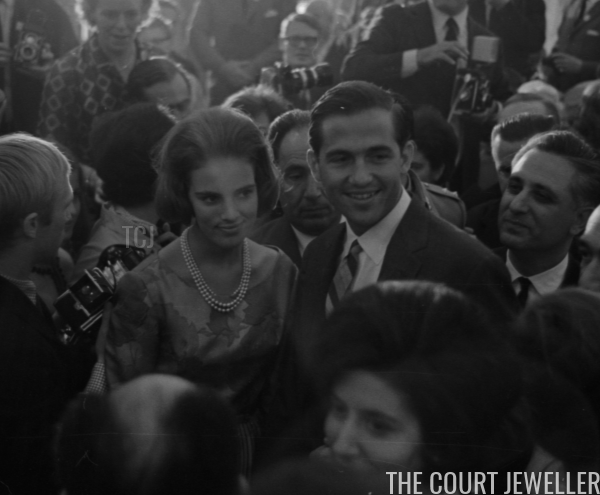 |
| Constantine and Anne-Marie, surrounded by press during her last day in Denmark, September 1964 (Victor Blackman/Express/Getty Images) |
An estimated crowd of 100,000 people gathered in the streets of Copenhagen to bid farewell to their princess on September 9 as she and Constantine rode through the rain-soaked streets of the capital in an open carriage. At a luncheon at the city hall, Anne-Marie gave a final speech: “This is a strange day for me, because this is the last time I will stand here as a Dane in my own country and my native city. So therefore I would like to say a deeply felt thank you to the many people all over the country who, with their greetings and gifts, have shown that they think of me. I am completely overwhelmed and deeply grateful.”
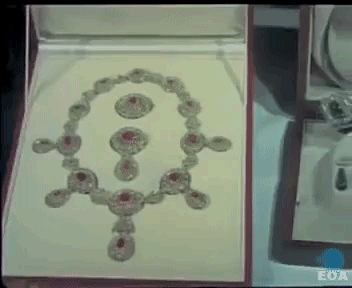 |
| The Greek rubies and emeralds, displayed with the couple’s wedding gifts, 1964 |
King Constantine II flew to Greece with Crown Princess Margrethe to await his bride, who traveled with her parents and Princess Benedikte to the Italian port of Brindisi, where they boarded the royal yacht, Dannebrog, to sail to Greece. Once the yacht approached the port of Piraeus, Constantine went aboard so that he could formally escort his bride on to the Greek shore. On September 11, shortly after the family’s arrival, the Greek government hosted a gala for the royals at the Hotel Grande Bretagne in Athens. At that gala, Princess Anne-Marie wore Greek royal jewels for the first time: the tiara and coordinating pieces from the family’s ruby parure, a gift from her new mother-in-law. (The jewels were also displayed with her wedding gifts.) The next few days were packed with receptions aimed at introducing Anne-Marie to the locals, including several parties at Tatoi Palace and a festival hosted by the armed forces at the Olympic Stadium. Though she was welcomed enthusiastically by many Greeks, she still struggled with their language. When King Constantine told reporters that Anne-Marie knew only five words of Greek, she interrupted: “Your Majesty is wrong. I know 25 Greek words.”
Guests from around the world descended upon Athens as the whirlwind of wedding festivities began. Lynda Bird Johnson, the young daughter of the American president, arrived to represent her father. An entire continent’s worth of monarchs were present in Athens, including King Gustaf VI Adolf (the bride’s grandfather) and Queen Louise of Sweden, King Baudouin and Queen Fabiola of Belgium, King Bhumibol Adulyadej and Queen Sirikit of Thailand, Queen Juliana and Prince Bernhard of the Netherlands (with Princess Beatrix), King Hussein (who had attended school with Constantine) and Princess Muna of Jordan, King Olav V of Norway (with Crown Prince Harald), Prince Franz Joseph and Princess Gina of Liechtenstein, and Prince Rainier III and Princess Grace of Monaco. (Both Queen Louise and Princess Grace attended some of the festivities but had to sit out the actual wedding ceremony due to the heat. Louise was in frail health, and Grace was expecting Princess Stephanie.) The former kings of Bulgaria, Romania, and Italy were also on the guest list, as were Hereditary Grand Duke Jean and Grand Duchess Josephine-Charlotte of Luxembourg and Lord Mountbatten. The only reigning European monarch not in attendance was Queen Elizabeth II, who was represented by her husband, the Duke of Edinburgh.
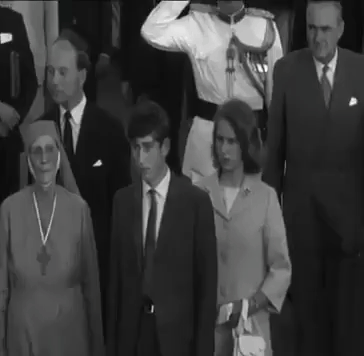 |
| Princess Andrew, Prince Charles, and Princess Anne arrive for the wedding |
The Greek royal family brought an impressive contingent of extended relatives, too. Constantine’s aunts and uncle, Queen Helen of Romania, Princess Irene, Duchess of Aosta, and Lady Katherine and Major Richard Brandram, were in attendance; so were Princess Andrew (with the Duke of Edinburgh, Prince Charles, and Princess Anne), Prince Michael, Princess Eugenie (with her husband and children), King Michael and Queen Anne of Romania with Princess Margareta, Princess Marina (with Prince Michael of Kent, Princess Alexandra, and Angus Ogilvy), Princess Olga, and Crown Prince Alexander of Yugoslavia. From Queen Friederike’s side of the family, Constantine’s grandmother, the Duchess of Brunswick, was present; his uncle, Prince Georg Wilhelm of Hanover, also attended with his wife, Princess Sophie of Greece and Denmark, and their children, Karl and Clarissa. Constantine’s sister, Sofia, attended with her husband, Juan Carlos; his sister, Infanta Pilar of Spain; and their parents, the Count and Countess of Barcelona.
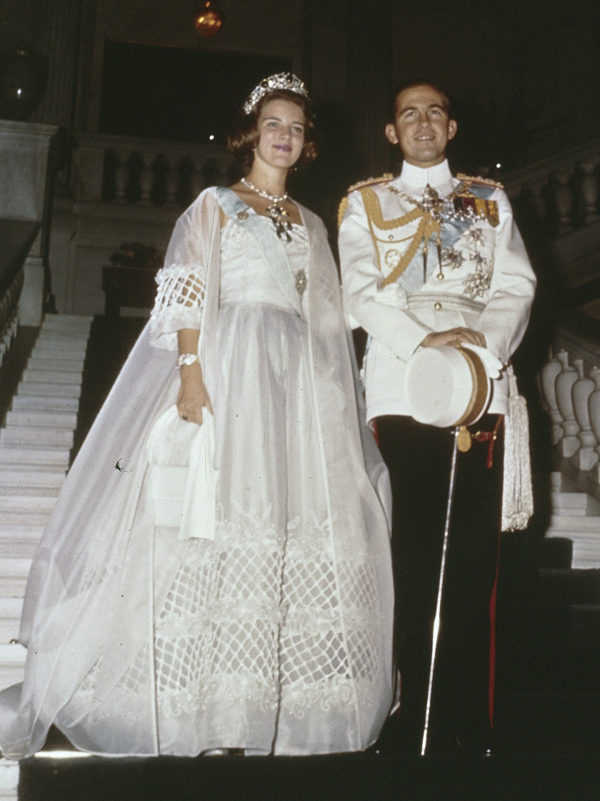 |
| Constantine and Anne-Marie attend a state ball ahead of their wedding (Anefo/Nationaal Archief/Wikimedia Commons) |
The family celebrated at a grand state ball on September 16 at the Royal Palace in Athens, which featured dozens of royals wearing “several million dollars worth of jewels, tiaras and handmade gowns,” according to press reports. Princess Anne-Marie debuted another wedding gift from Queen Friederike: the grand Greek Emerald Parure, set with Romanov stones that came to the country with Queen Olga.
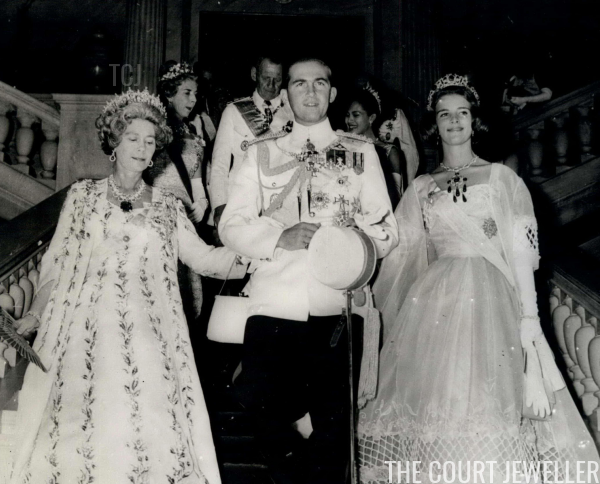 |
| Queen Friederike, King Constantine, Princess Anne-Marie, Queen Ingrid, King Frederik, and Queen Sirikit arrive for the state ball (Keystone Pictures/ZumaPress/Alamy) |
Queen Friederike wore Queen Sophie’s Diamond Tiara, plus her convertible pearl and diamond necklace with Queen Marie of Romania’s sapphire pendant. In the background of the photo, you’ll also spot Queen Ingrid wearing the Danish rubies, and Queen Sirikit of Thailand wearing a diamond tiara.
 |
| Princess Irene of Greece and Denmark, Prince Rainier III of Monaco, Crown Princess Margrethe of Denmark, Princess Benedikte of Denmark, Prince Bernhard of the Netherlands, and Princess Anne of the United Kingdom arrive for the state ball at the Royal Palace in Athens |
Crown Princess Margrethe wore the Alexandrine Diamond Drop Tiara, Princess Benedikte wore her Floral Birthday Tiara, and Princess Irene wore Queen Sophie’s Diamond Circle Tiara.
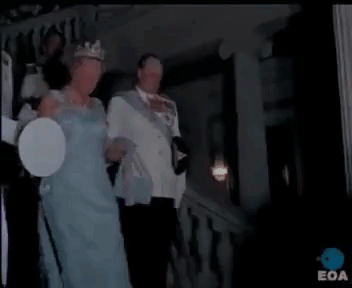 |
| King Gustaf VI Adolf of Sweden, Queen Juliana of the Netherlands, and King Olav V of Norway arrive for the state ball at the Royal Palace in Athens |
The rest of the royals wore some seriously impressive jewels, too. Just to name a few … Marie Jose, the former queen of Italy, wore her grand diamond tiara by Musy. Queen Juliana of the Netherlands wore the Stuart Tiara. Queen Fabiola of the Belgians wore the Spanish Wedding Gift Tiara in its floral wreath form. The Countess of Barcelona wore her Diamond Loop Tiara. Queen Sofia of Spain, then still Princess Sofia, wore the Prussian Tiara. Princess Grace of Monaco wore a red gown with her small diamond tiara. Princess Claude of Orleans — who had married Constantine’s first cousin, Prince Amedeo, Duke of Aosta, only weeks earlier — wore the family’s diamond tiara with stars and Aosta knots. Can you imagine what it must have been like to stand in that ballroom?!?
On the day of the wedding, September 18, 1964, Princess Anne-Marie dressed in a white gown by the Danish designer Jørgen Bender. (When Constantine had asked her earlier what her wedding gown looked like, she reportedly replied cheekily, “It’s bright red.”) In reality, her dress was “of duchesse satin, in classic Greek style with a high waist and simple lines” and ended “in a short train of frilled silk organza, while another train 40 feet long fell from her shoulders and was carried by her six bridesmaids.” Those bridesmaids, all royal princesses, were Princess Christina of Sweden, Princess Anne of the United Kingdom, Princess Irene of Greece and Denmark, Princess Clarissa of Hesse, Princess Margareta of Romania, and Princess Tatiana Radziwill.
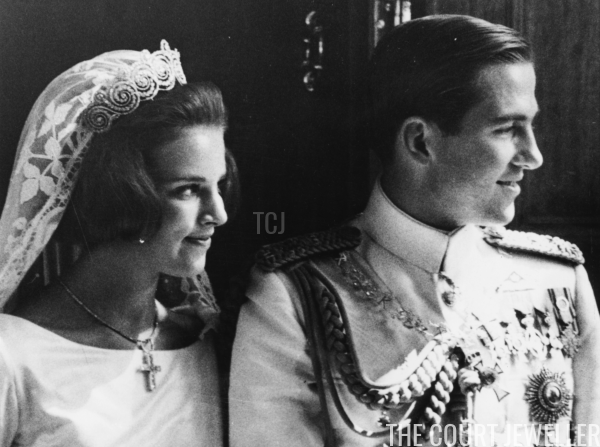 |
| Central Press/Hulton Archive/Getty Images |
Princess Anne-Marie’s veil and tiara were both important royal heirlooms. Both had belonged to her late grandmother, Princess Margaret of Connaught. The veil had been one of Margaret’s wedding gifts, and Queen Ingrid wore it on her own wedding day. Anne-Marie’s bridal diadem, the Khedive of Egypt Tiara, was also one of Margaret’s wedding gifts. Anne-Marie was the first royal bride to wear the Khedive Tiara, a tradition that was followed by both of her sisters, her daughter, and her two nieces. She also wore a simple necklace with a large diamond cross.
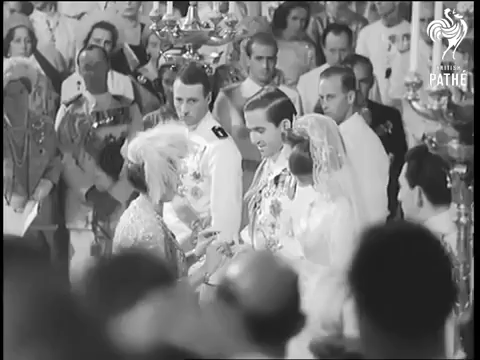 |
| Queen Friederike puts wedding rings on the couple’s fingers |
Inside Athens’s Metropolitan Cathedral, King Constantine and Princess Anne-Marie were married by the Archbishop of Athens. Their chief sponsor for the wedding was Queen Friederike, who placed on their fingers golden wedding rings made from melted down coins from the reign of Alexander the Great. While Anne-Marie “showed only a few momentary traces of nervousness” during the ceremony, the press reported that “Constantine was so nervous that he had to blink back tears .. white-faced and obviously suffering from nerves that threatened to take control.” The guests sweated in the heat of the cathedral.
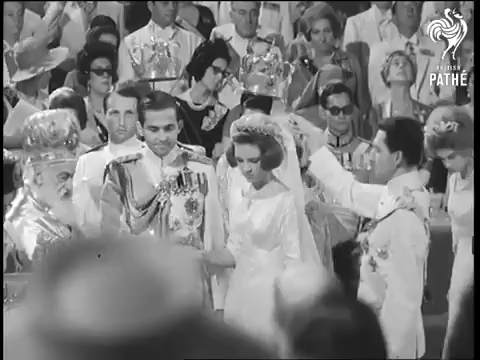 |
| Crown Prince Harald of Norway and Prince Michael of Greece and Denmark hold crowns over the heads of the bride and groom |
But the ceremony proceeded without any major disruptions, save one moment when Anne-Marie got a minor case of the giggles, and another when Queen Friederike nearly clobbered Prince Charles with one of the gold wedding crowns. (One newspaper dead-panned that “Charles did not duck, but he eyed the heavy crowns with concern.”) In total, nine royal men served as crown bearers during the wedding ceremony: Prince Charles, Crown Prince Harald of Norway, Crown Prince Carl Gustaf of Sweden, Prince Ingolf of Denmark, Prince Michael of Greece and Denmark, Prince Michael of Kent, Crown Prince Alexander of Yugoslavia, Prince Karl of Hesse, and Count Michael Bernadotte af Wisborg.
Queen Ingrid wore a deep turquoise gown and matching feathered hat for the wedding. She accessorized with pieces from the married Pearl Poire Parure — the earrings, necklace, and brooch.
Here’s another view where you can spot some of the guests’ jewels. Princess Benedikte wore a multi-stranded necklace of pearls, while Queen Fabiola wore the necklace setting of the Spanish Wedding Gift Tiara (with rubies).
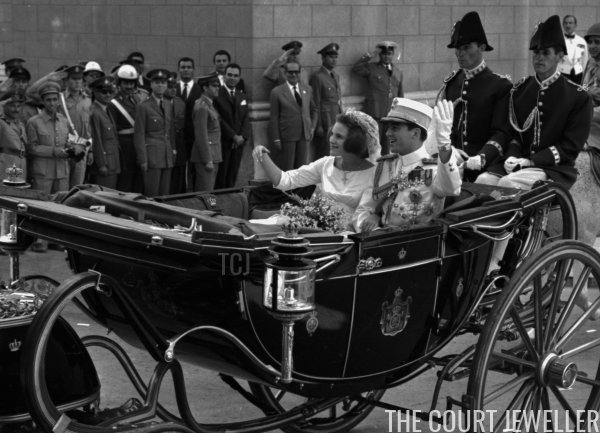 |
| Constantine and Anne-Marie process through Athens after their wedding (Victor Blackman/Express/Getty Images) |
When the forty-five minute ceremony ended, King Constantine and the new Queen Anne-Marie emerged into the brilliant Greek sunlight. The couple processed through the streets of Athens in an open carriage pulled by six white horses under a blue sky. Press reports estimated that a million Greeks thronged the streets to see the couple pass by. (The wedding day had been declared a national holiday.) A 101-gun salute was fired from Mount Lycabettus, and church bells rang throughout Athens. The couple and their guests arrived back at the palace for a wedding banquet. Later, the couple departed for an island honeymoon in the Aegean Sea.
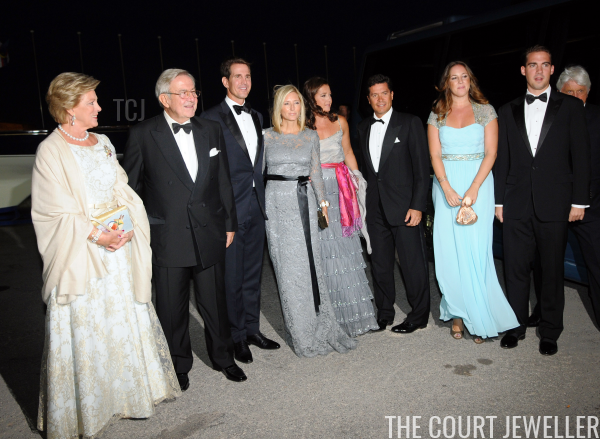 |
| Constantine and Anne-Marie’s golden wedding celebration, held at the yacht club in Piraeus, September 2014 (Milos Bicanski/Getty Images) |
Though their wedding day was an especially lovely one, and the couple’s marriage has endured, Anne-Marie’s father was right to be worried about their future in Greece. The couple went into exile following a military coup in 1967, and the Greek monarchy was officially abolished by referendum seven years later. The couple raised five children — Princess Alexia, Crown Prince Pavlos, Prince Nikolaos, Princess Theodora, and Prince Philippos — in England, but in recent years, they’ve been allowed to return to Greece. In September 2014, they were able to celebrate their golden wedding anniversary with their family in Athens.
- « Previous Page
- 1
- …
- 42
- 43
- 44
- 45
- 46
- …
- 248
- Next Page »